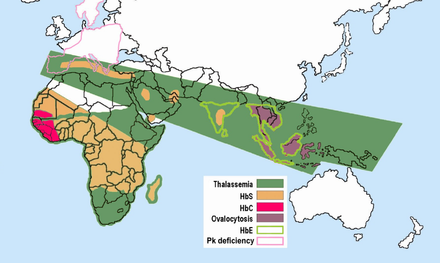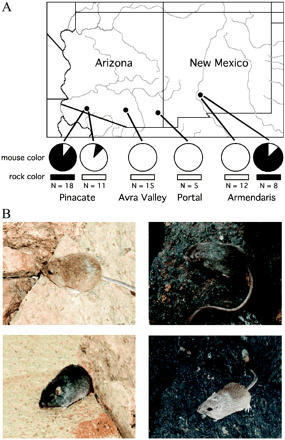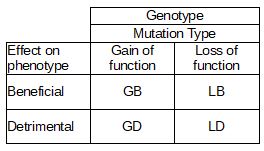So if the natural process of mutagenesis produced those mutations then those would be beneficial mutations, correct?
Yes you are. I have already said that genetic defects can be beneficial in some circumstances. However neither adult lactose tolerance nor sickle cell trait result from new genetic material; both are the result of genetic defects. Your mistake is to conflate what happens at the genetic level with benefit/detriment at the phenotype level.
Absolutely right.
But centuries ago… if you were in it… the sickle mutation was a statistical blessing for the population… and there was no such thing as living without exposure to malaria.
This mutation arose in Africa, where malaria is very common.
Very much so. Still number one in worldwide cause of death from infectious disease, I think. That’s why the Gates Foundation is working on it. I even had it, and therefore I can’t donate blood anymore. Also, I think Alpha and beta thalassemia from the Mediterranean region are adaptations to help in a similar way against malaria.
Yes, God bless the Gates Foundation!
Some areas have malaria, some don’t. There was and is such a thing as living without exposure to malaria.
Even in malaria prone areas the benefit of sickle cell is not a blessing as shown by it never reaching more than ~18% frequency in the population. That means 0.8^2=64% of the population do not carry the trait. It is of some benefit but not a blessing.
How much did God affect evolution? I suppose that depends on how many wrong turns He took at the outset in setting it going and just how difficult He found it to foresee results. Perhaps He required no further inputs at all?

Good point. Here is a map correlating some of the genetic mutations that increased in frequency in response to malaria pressure. One does not need them where there is no malaria. Have you enjoyed Survival of the Sickest yet? No pressure. Just really interesting. I think AIG would have No problem with this map or the book.
How much did God affect evolution?
Enough to make sure evolution continued and life did not die out in the universe? Yes.
Enough to make sure species were sufficiently challenged on the Earth, in order to develop more complex forms. Probably.
Enough to make sure language capable intelligence evolved in our particular species? Perhaps.
Enough to make sure we have the human form and shape? Unlikely.
Enough to say that all diseases exist for some higher purpose in God’s plan? No.
I have no doubt that God intended language capable intelligence to evolve, but he could have had many candidates for that development and thus did not require it for our particular species. Diversity and competition is a common enough pattern that I see no reason why this would not play a role.
This looks like the old choice between Deism and theism. I am a Theist. But, this does not mean God micromanaged, keeping control of everything. I think it highly likely that God delegated many tasks to the angels in addition to leaving us with considerable freedom to make our own choices.
But that wasnt the question . The question was whether genes, especially negative ones, could ever produce enough benefit to explain their prevalence.
I have always liked this map because it shows the distribution of the hemS allele and endemic malaria:
Yes. Both ways.
In the case of sickle cell the benefits explain why it is at increased frequency in malaria prone areas and the detriments explain why in those areas it does not increase to higher than 18%. In other areas the detriments explain why it remains at very low frequency.
Similarly with Thalassemia.
So… it’s easy to see that evolution is not always a step to destruction or deterioration, yes? Or are you going to balk at that?
There are also examples of mutations that are not detrimental in any way within the environments where they are beneficial. For example, mutations that give mice black fur color is very beneficial in areas with black basalt. However, outside of the areas with black rocks they stick out and the fur color is detrimental. The black fur color is a dominant allele and there is unrestricted mating between the populations with black fur and those with brown fur, yet you can’t find black mice very far away from the areas with black rocks.

I like this demonstration, and also the Heme S gene distribution.
. I don’t think Ken Ham would have any problem with this idea, though, based on my YEC Beka Book text from 9th grade (ages ago) in which they reviewed the moth changes in England with the coal dust coating trees during the Industrial Revolution.
Chris,
You are thinking of biological traits as if they were moral–as if they could have a correct state and a defective state.
This is a completely wrong way to think of biological traits. Instead, each trait occupies a position along a cost-benefit axis. There are trade-offs along the axis, such that a particular trait might optimize for one aspect while accepting an associated cost. Another trait along the axis might try to strike a middle ground. A few examples can illustrate what I’m talking about.
Body size: Combat Effectiveness vs. Energy Needs
A large animal like an elephant is harder to bring down as prey than, say, a squirrel. But a population of squirrels might be able to survive an extended drought, as some members are able to subsist and reproduce using small amounts of food. A population of elephants might not be able to survive the same drought.
Deer seems to take the middle path: large enough to survive attacks from small predators like snakes, but not so large that they cannot adapt to habitats with modest food supplies.
Flight: Energy Consumption vs. Advantages of air travel
Flight requires strong muscles, which in turn require lots of energy. But travel by air can help prey escape ground-based predators, and can help predators hunt ground-based prey.
When a bird population reaches a remote island with no natural predators, they can over time lose the ability to fly. Flight no longer offers an advantage, but the cost remains. Thus natural selection pushes the bird population away from flight. This dynamic explains how dodo birds evolved from ancestors that flew.
Other Examples
- Increased Intelligence: multiple capabilities vs. longer juvenile dependence on parents and increased energy consumption.
- Fat Storage: drought survival vs. cardiovascular disease
- Asperger’s: task focus vs. social understanding
- Down’s syndrome: complex intellectual task capability vs. amiability
Conclusion:
There is no such thing as a trait that has no costs. I only provided a few examples, but I could have (at a great cost in time–that’s the trade-off!) presented a few thousand. A change in a trait can increase capability in one or more ways, but it is inevitably accompanied by one or more associated costs. There is no such thing as a free lunch.
The mutations we have been discussing (lactase persistence and sickle cell trait in humans, antibiotic resistance in bacteria) represent a “choice” along one or more cost-benefit axes. This is not surprising; there is no such thing as a free lunch. In some environments, the trait’s new position on the trade-off axis is beneficial, so positive selection pressure makes it more common. In other environments, the trait’s new position is less beneficial, so it is under negative selection pressure.
It is also possible that the environment fluctuates enough that a population would have different traits in the same gene pool. This is why different alleles of the same gene can persist in a single population.
I hope that this higher-level view of the dynamic forces in nature helps you understand the theory of evolution better.
Best regards,
Chris Falter
You need to avoid conflating changes in the genotype with effect on the phenotype. It is tempting to think that a mutation that is beneficial is “gain of function” in the genotype; and vice versa. A more sophisticated understanding decouples the two as shown in the diagram below.

Going back to adult lactose tolerance, this is beneficial where there is access to dairy products, but in the genome it is due to a loss of function of the regulatory system that turns off lactase production after weaning.
Similarly in desert mice (@T_aquaticus) a loss of signalling between two proteins results in excess production of melanin and hence in black fur which is beneficial if the mice live black lava rock country (and detrimental if they live in sand country).
Sickle cell trait is perhaps more straight forward. The change to hemoglobin is definitely a defect, both in the genome and in the phenome. Think what would happen if the sickle cell trait reached 100% frequency in a population. Everyone would have sickle cell anemia with significantly reduced life expectancy (although much better with modern medical treatment). This is why even in malarial areas the frequency does not rise above 18% and is often much lower (see map by @T_aquaticus above). Even when a person is heterogeneous for the trait there are still health issues although nowhere near as severe as full sickle cell disease. Nevertheless at low frequencies it has a net benefit in protection against malaria.
So are there “gain of function” mutations that have a beneficial effect for the phenotype? I can think of one although it is fairly trivial.
So, if a tetrapod loses the function of its gills… but has developed goid use of lungs… that is still evolugion, yes?
I have found the work that was awarded the Nobel prize in chemistry thought provoking, as its main thesis is directed evolution. It seems to me to support ideas on evolution that may include external direction. Does this imply an “affect” by a power outside of nature? I would be especially interested in views from atheists who participate on this blog.
